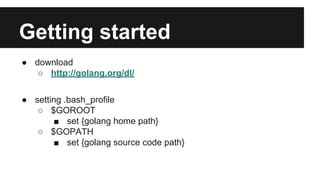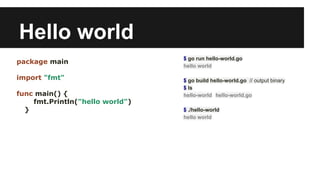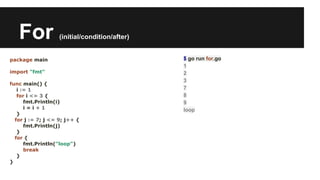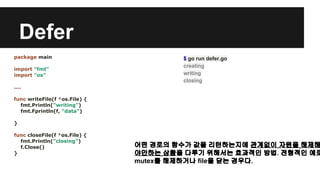The document provides an overview of the Go programming language, including its history, data types, basic syntax like variables and functions, and common constructs like arrays, slices, maps, and concurrency features. It was developed at Google in 2009 and aims to provide efficiency of static typing with ease of dynamic languages through features like garbage collection and good support for concurrency and communication.









![Arrays
package main
import "fmt"
func main() {
var a [5]int
fmt.Println("emp:", a)
a[4] = 100
fmt.Println("set:", a)
fmt.Println("get:", a[4])
fmt.Println("len:", len(a))
b := [5]int{1, 2, 3, 4, 5}
fmt.Println("dcl:", b)
var twoD [2][3]int
for i := 0; i < 2; i++ {
for j := 0; j < 3; j++ {
twoD[i][j] = i + j
}
}
fmt.Println("2d: ", twoD)
}
$ go run arrays.go
emp: [0 0 0 0 0]
set: [0 0 0 0 100]
get: 100
len: 5
dcl: [1 2 3 4 5]
2d: [[0 1 2] [1 2 3]]](https://image.slidesharecdn.com/letsgolang3-141208080147-conversion-gate02/85/Let-s-golang-10-320.jpg)
![Slices (array 보다 많이 사용)
package main
import "fmt"
func main() {
s := make([]string, 3)
fmt.Println("emp:", s)
s[0] = "a"
s[1] = "b"
s[2] = "c"
fmt.Println("set:", s)
fmt.Println("get:", s[2])
fmt.Println("len:", len(s))
s = append(s, "d")
s = append(s, "e", "f")
fmt.Println("apd:", s)
…. (next)
$ go run slices.go
emp: [ ]
set: [a b c]
get: c
len: 3
apd: [a b c d e f]](https://image.slidesharecdn.com/letsgolang3-141208080147-conversion-gate02/85/Let-s-golang-11-320.jpg)
![Slices (slice[low:high])
package main
import "fmt"
func main() {
…
c := make([]string, len(s))
copy(c, s)
fmt.Println("cpy:", c)
l := s[2:5] //elements s[2], s[3], and s[4]
fmt.Println("sl1:", l)
l = s[:5] //This slices up to (but excluding) s[5]
fmt.Println("sl2:", l)
l = s[2:] //This slices up from (and including) s[2]
fmt.Println("sl3:", l)
… (next)
$ go run slices.go
cpy: [a b c d e f]
sl1: [c d e]
sl2: [a b c d e]
sl3: [c d e f]
dcl: [g h i]
2d: [[0] [1 2] [2 3 4]]](https://image.slidesharecdn.com/letsgolang3-141208080147-conversion-gate02/85/Let-s-golang-12-320.jpg)
![Slices (array 보다 많이 사용)
package main
import "fmt"
func main() {
…
t := []string{"g", "h", "i"}
fmt.Println("dcl:", t)
twoD := make([][]int, 3)
for i := 0; i < 3; i++ {
innerLen := i + 1
twoD[i] = make([]int, innerLen)
for j := 0; j < innerLen; j++ {
twoD[i][j] = i + j
}
}
fmt.Println("2d: ", twoD)
}
$ go run slices.go
dcl: [g h i]
2d: [[0] [1 2] [2 3 4]]](https://image.slidesharecdn.com/letsgolang3-141208080147-conversion-gate02/85/Let-s-golang-13-320.jpg)
![Slices internals
Our variable s, created earlier by make([]byte, 5), is structured like this:
The length is the number](https://image.slidesharecdn.com/letsgolang3-141208080147-conversion-gate02/85/Let-s-golang-14-320.jpg)
![Maps make(map[key-type]val-type) (다른 언어 : hashes 나 dicts로 불리움)
package main
import "fmt"
func main() {
m := make(map[string]int)
m["k1"] = 7
m["k2"] = 13
fmt.Println("map:", m)
v1 := m["k1"]
fmt.Println("v1: ", v1)
fmt.Println("len:", len(m))
… (next)
}
$ go run maps.go
map: map[k1:7 k2:13]
v1: 7
len: 2](https://image.slidesharecdn.com/letsgolang3-141208080147-conversion-gate02/85/Let-s-golang-15-320.jpg)
![Maps make(map[key-type]val-type) (다른 언어 : hashes 나 dicts로 불리움)
package main
import "fmt"
func main() {
…
delete(m, "k2")
fmt.Println("map:", m)
_, prs := m["k2"]
fmt.Println("prs:", prs)
n := map[string]int{"foo": 1, "bar": 2}
fmt.Println("map:", n)
}
$ go run slices.go
map: map[k1:7]
prs: false
map: map[foo:1 bar:2]](https://image.slidesharecdn.com/letsgolang3-141208080147-conversion-gate02/85/Let-s-golang-16-320.jpg)


![Java vs golang
모든 짝수번째 숫자를 * 로 치환하시오.(홀수번째 숫자,또는 짝수번째 문자를 치환하면 안됩니다.)
Example: a1b2cde3~g45hi6 → a*b*cde*~g4*hi6
java go
public static void main(String args[]){
String text = "a1b2cde3~g45hi6";
String replace = "";
for(int i=0; i<text.length();i++){
char charAt = text.charAt(i);
if(i % 2 != 0 && Character.isDigit(charAt)){
charAt = '*';
}
replace += charAt;
}
System.out.print(replace);
}
func main() {
str := "a1b2cde3~g45hi6"
for index, runeValue := range str {
if unicode.IsDigit(runeValue) && index % 2 != 0 {
str = strings.Replace(str, string(runeValue), "*", -1)
}
}
fmt.Printf(str)
}](https://image.slidesharecdn.com/letsgolang3-141208080147-conversion-gate02/85/Let-s-golang-19-320.jpg)

